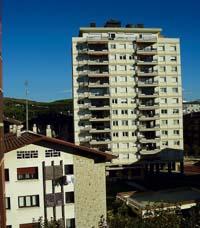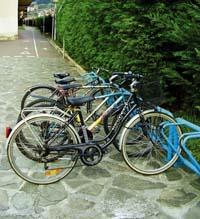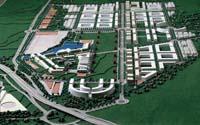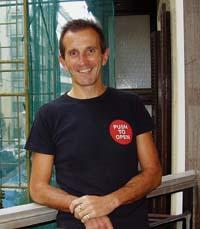Sustainable Basque urbanism?

It seems that the key is to be sustainable, also in urbanism. It seems complicated and, in addition, there are those who do not have clear what sustainable urbanism means. But the concept is no longer so new or the intention to carry it out. The United Nations held in 1996 a conference on cities and places of residence, in which they created a Habitat II Program in which sustainability is one of the fundamental pillars.
The document that presents the framework of action for the sustainable development of the cities of the European Union dates from 1999, and sustainable urbanism continues to advance here. For example, the Department of the Environment of the Basque Government published in 2003 the document “Sustainability criteria applicable to urban planning”.
As recognized in the introduction of the document, earlier urbanism was mainly related to architecture and engineering, and was concerned about sustainability in the field of natural sciences. Later, when the concept of sustainability was introduced in the urbanism, it was applied quite slightly, limiting itself to aspects related to the environment (noise, water purification, energy, waste...).

Today, however, the terms urbanism and sustainable appear together. It is still early to know if sustainable urbanism will remain in an idea or will become a reality, but politicians, at least in theory, have defended it.
To move from theory to practice, many steps must be taken. For example, it is essential to take into account citizen participation and this is recognized by the Department of Environment in the aforementioned document. According to them, Local Agenda 21 and processes like this are important elements for the integration of sustainability criteria in urbanism.
City and land
It is evident that there are more and more people in the cities, not only in Euskal Herria, but all over the world. However, cities are expanding, as the surrounding lands are destined in part to their uses.
Here, in addition, there is a change in the aspect of cities, which increasingly occupy more land. In the 1960s and 1970s, the population grew a lot, while cities grew rapidly and without excessive controls. Many new neighborhoods emerged, mostly compact. Since the 1990s, however, the growth of the population has stagnated, but not the consumption of soil. The trend towards the substitution of compact neighbourhoods by dispersed urbanizations with low population density is expanded, even in places where the orography delimits the space.

Therefore, in the document of the Basque Government on criteria of urban sustainability, the first criterion in addressing an urban planning is as follows: "the evaluation of the ecological footprint of the city, the calculation of the cargo capacity of the territory in which the object city is located and the analysis of the possibility of reuse of the urban soils used before the loading of the unused soils".
Eleven criteria: Eleven criteria
This criterion appears in the initial part of the document and in the conclusions appears first. But the following have no less interest and relevance. Some are related to soil and nature, such as respect for the initial natural ecosystem and protection of the areas of greater ecological value.
Although it is not new, it is an essential criterion. It is so necessary, but perhaps less heard, to capitalize on the potential of the site (climate, orography...). The goal is to achieve a comfortable city, with the lowest possible energy consumption and the lowest possible impact.

The consideration of the city as a living organism and the talk of the metabolism of the city remains rare for some. Well, in another of the criteria we talk about a deep analysis of the functioning of the urban metabolism and the conditions of the environment to serve as a base for planning.
Along with this, another criterion is the design of the network of green spaces. This network would cover elements of all levels, both the urban natural spaces and the protected spaces of the environment. In this way, the fragmentation and/or abandonment of natural systems is avoided. The idea is to integrate nature into the city.
Other criteria refer to urban facilities, services, public spaces, etc. For example, the document indicates that equipment and services must be distributed in a balanced way to achieve a short distance city.
To facilitate coexistence, it is recommended the creation of a system of public spaces and the need for the renovation of all spaces to be integrated to avoid the creation of marginal neighborhoods. In short, it is a question of achieving a balance between urban nuclei.
This affects mobility directly, since when the distances are small and when the services are close, there is the possibility of walking or cycling, thus avoiding the increase in traffic. But this is not enough to solve mobility problems and another criterion is to prioritize the use of collective transport.

From paper to street
However, the reference document has been in place for several years. On the other hand, some of the ideas previously were considered necessary and, to some extent, were being executed in different places. In addition, the regulations and laws issued by the European Union in recent years go the same way and affect the decisions of the administrations.
Thus, although it is difficult to pass from morning to night, some have taken great steps in that direction. For example, it is worth mentioning the urban waste management program of the Region of Pamplona. This program was launched in 1986 and is still an example. He was the first to apply the principles of reuse and recycling in the Spanish State and in the Basque Country. The participation of society was spectacular.

The program has advanced and has received numerous awards and distinctions, some international. In addition, it has been applied in other municipalities, adapting to the place, both in Navarre and outside (Madrid, Barcelona, Cordoba...), since it has been shown that it is theoretically coherent and at the same time practical.
In the case of Navarre, it is worth mentioning the idea of carrying out an eco-city in Sarriguren. Sarriguren is located in a rural area close to Pamplona and currently has 10 inhabitants. In this place they want to create an exemplary city with 4,200 homes of limited price and the plan is part of the Habitat II program of sustainable cities of the United Nations.
These are two examples of Navarre. One of them has been in progress for a long time, the other is still in the project phase, but both are examples and have recognized it, among others, in the Habitat II program of the United Nations. The program includes other cities of Euskal Herria as the green belt of Vitoria-Gasteiz, the regeneration of Barakaldo...
In addition to these mentions, the territory has received more general awards, such as the Council of European Urbanists, which has awarded the Planning of the Territory of the CAPV, and the Partial Plan of the Low Must, which has received a special mention. The awards were presented at the Euskal Hiria 2006 Congress, which received from the President of the European Council of Urban Planners, Jan Vogelij, the Basque Country Environment Council, Esther Larrañaga.
Polycentric model and means of transport

Simin Davoudi, expert speaker at the Euskal Hiria congress, also congratulated the Basque plan. Davoudi is a researcher at the University of Newcastle and an urbanism advisor in the British government and the European Union. And, precisely, his intervention focused on an urban polycentric region. He explained how this model was, specified its characteristics and gave some examples.
In two words, in the polycentric urban regions there are three or more major cities, there are no hierarchical relationships between them, they are relatively close and functionally complementary. The classic example is the Dutch Randstad.
Apparently, the CAPV also has this characteristic or, at least, is sought by the Basque Government through the Guidelines for Territorial Planning. However, at the congress not all were positive awards and lectures, there were criticism. The biggest debate was the creation of high-speed trains and new tracks.
At the round table of the congress were gathered experts who have made the diagnosis of the Guidelines for the Planning of the Territory of the CAPV: Xabier Unzurrunzaga, Jose Allende, Eugenio Ruiz Urrestarazu, Arantxa Rodríguez and Santiago Peñalba. Although the five bet on collective transport and, above all, on the railroad, they agreed that there was no public debate on the high-speed train and the railroad. And that does not seem appropriate to them.

Moreover, Allende, Rodríguez and Peñalba believe that this train will strengthen Bilbao, Donostia-San Sebastián and Vitoria-Gasteiz and exclude intermediate cities and towns. Therefore, they consider it contrary to the polycentric model. But they are not the only ones who do not see this project with good eyes, but groups have also been created in society.
However, the leaders of the Basque Government support the Basque Y and expect that the benefits - social, economic and environmental - are much greater than the damage. Construction works begin, we will see where this train takes us.








